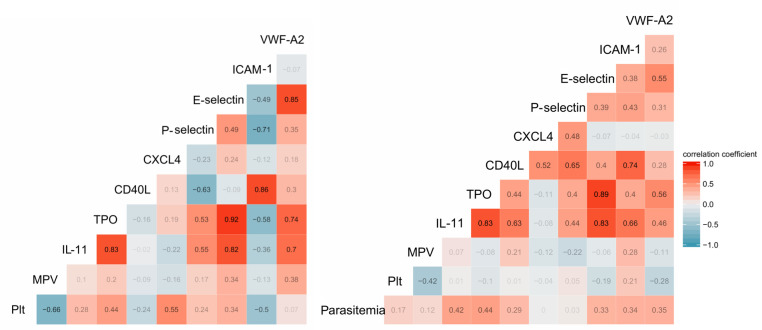Platelet disturbances correlate with endothelial cell activation in uncomplicated Plasmodium vivax malaria.
Platelets drive endothelial cell activation in many diseases. However, if this occurs in Plasmodium vivax malaria is unclear. As platelets have been reported to be activated and to play a role in inflammatory response during malaria, we hypothesized that this would correlate with endothelial alterations during acute illness. We performed platelet flow cytometry of PAC-1 and P-selectin. We measured platelet markers (CXCL4, CD40L, P-selectin, Thrombopoietin, IL-11) and endothelial activation markers (ICAM-1, von Willebrand Factor and E-selectin) in plasma with a multiplex-based assay. The values of each mediator were used to generate heatmaps, K-means clustering and Principal Component analysis. In addition, we determined pair-wise Pearson's correlation coefficients to generate correlation networks. Platelet counts were reduced, and mean platelet volume increased in malaria patients. The activation of circulating platelets in flow cytometry did not differ between patients and controls. CD40L levels (Median [IQ]: 517 [406-651] vs. 1029 [732-1267] pg/mL, P = 0.0001) were significantly higher in patients, while P-selectin and CXCL4 showed a nonsignificant trend towards higher levels in patients. The network correlation approach demonstrated the correlation between markers of platelet and endothelial activation, and the heatmaps revealed a distinct pattern of activation in two subsets of P. vivax patients when compared to controls. Although absolute platelet activation was not strong in uncomplicated vivax malaria, markers of platelet activity and production were correlated with higher endothelial cell activation, especially in a specific subset of patients.
Authors
João Conrado Khouri Dos-Santos; João Luiz Silva-Filho; Carla C Judice; Ana Carolina Andrade Vitor Kayano; Júlio Aliberti; Ricardo Khouri; Diógenes S de Lima; Helder Nakaya; Marcus Vinicius Guimarães Lacerda; Erich Vinicius De Paula; Stefanie Costa Pinto Lopes; Fabio Trindade Maranhão Costa
External link
Publication Year
Publication Journal
Associeted Project
Systems Immunology of Human Diseases
Lista de serviços
-
Genomic analyses reveal broad impact of miR-137 on genes associated with malignant transformation and neuronal differentiation in glioblastoma cells.Genomic analyses reveal broad impact of miR-137 on genes associated with malignant transformation and neuronal differentiation in glioblastoma cells.
-
RNA-Binding Protein Musashi1 Is a Central Regulator of Adhesion Pathways in Glioblastoma.RNA-Binding Protein Musashi1 Is a Central Regulator of Adhesion Pathways in Glioblastoma.
-
MicroRNA Transcriptome Profiling in Heart of Trypanosoma cruzi-Infected Mice: Parasitological and Cardiological Outcomes.MicroRNA Transcriptome Profiling in Heart of Trypanosoma cruzi-Infected Mice: Parasitological and Cardiological Outcomes.
-
Genome mapping and expression analyses of human intronic noncoding RNAs reveal tissue-specific patterns and enrichment in genes related to regulation of transcription.Genome mapping and expression analyses of human intronic noncoding RNAs reveal tissue-specific patterns and enrichment in genes related to regulation of transcription.
-
Antimicrobial peptide LL-37 participates in the transcriptional regulation of melanoma cells.Antimicrobial peptide LL-37 participates in the transcriptional regulation of melanoma cells.
-
Down-regulation of 14q32-encoded miRNAs and tumor suppressor role for miR-654-3p in papillary thyroid cancer.Down-regulation of 14q32-encoded miRNAs and tumor suppressor role for miR-654-3p in papillary thyroid cancer.
-
Integration of miRNA and gene expression profiles suggest a role for miRNAs in the pathobiological processes of acute Trypanosoma cruzi infection.Integration of miRNA and gene expression profiles suggest a role for miRNAs in the pathobiological processes of acute Trypanosoma cruzi infection.
-
Integrative Biology Approaches Applied to Human DiseasesIntegrative Biology Approaches Applied to Human Diseases
-
Proteomics reveals disturbances in the immune response and energy metabolism of monocytes from patients with septic shock.Proteomics reveals disturbances in the immune response and energy metabolism of monocytes from patients with septic shock.
-
Genomics, epigenomics and pharmacogenomics of Familial Hypercholesterolemia (FHBGEP): A study protocol.Genomics, epigenomics and pharmacogenomics of Familial Hypercholesterolemia (FHBGEP): A study protocol.
-
Melatonin-Index as a biomarker for predicting the distribution of presymptomatic and asymptomatic SARS-CoV-2 carriersMelatonin-Index as a biomarker for predicting the distribution of presymptomatic and asymptomatic SARS-CoV-2 carriers
-
Profiling plasma-extracellular vesicle proteins and microRNAs in diabetes onset in middle-aged male participants in the ELSA-Brasil study.Profiling plasma-extracellular vesicle proteins and microRNAs in diabetes onset in middle-aged male participants in the ELSA-Brasil study.
-
Big Data and machine learning in cancer theranosticsBig Data and machine learning in cancer theranostics
-
Genomic positional conservation identifies topological anchor point RNAs linked to developmental loci.Genomic positional conservation identifies topological anchor point RNAs linked to developmental loci.
-
Integrative systems immunology uncovers molecular networks of the cell cycle that stratify COVID-19 severityIntegrative systems immunology uncovers molecular networks of the cell cycle that stratify COVID-19 severity

